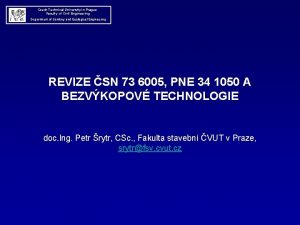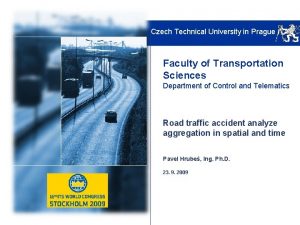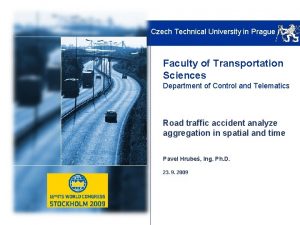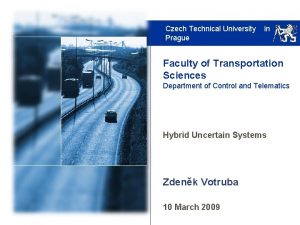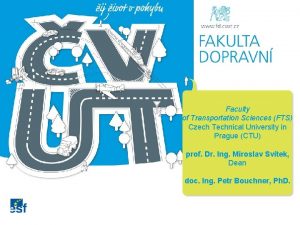Czech Technical University in Prague Faculty of Transportation




























- Slides: 28

Czech Technical University in Prague Faculty of Transportation Sciences Department of Transport Telematics Geographical Information Systems Doc. Ing. Pavel Hrubeš, Ph. D.

Rehearsal § Vector data models § § Spaghetti model Topological model Czech Technical University in Prague - Faculty of Transportation Sciences Department of Transport Telematics

Model of the Earth § Sphere § Big scales § Elipsoid/Spheroid § Closer to reality § Geoid § The closest to reality § Model of elevation Czech Technical University in Prague - Faculty of Transportation Sciences Department of Transport Telematics České vysoké učení technick év Praze Fakulta dopravní Katedra řídící techniky a telematik y

Parameters for Mapping § A mathematical model of the earth must be selected. Spheroid § The mathematical model must be related to real-world features. Datum § Real-world features must be projected with minimum distortion from a round earth to a flat map; and given a grid system of coordinates. Projection Czech Technical University in Prague - Faculty of Transportation Sciences Department of Transport Telematics

Spheroid A mathematical model of the earth must be selected. § Simplistic - A round ball having a radius big enough to approximate the size of the earth. § Reality - Spinning planets bulge at the equator with reciprocal flattening at the poles. e. g. § Czech Technical University in Prague - Faculty of Transportation Sciences Department of Transport Telematics

Different Spheroids • GRS 80 (North America) • Clark 1866 (North America) • WGS 84 (GPS World-wide) • International 1924 (Europe) • Bessel 1841 (Europe) Name Equatorial axis (m) Airy 1830 6 377 563. 4 Clarke 1866 6 378 206. 4 Bessel 1841 6 377 397. 155 International 1924 6 378 388 Krasovsky 1940 6 378 245 GRS 1980 6 378 137 WGS 1984 6 378 137 Sphere (6371 km) 6 371 000 Polar axis (m) 6 356 256. 9 6 356 583. 8 6 356 078. 965 6 356 911. 9 6 356 863 6 356 752. 3141 6 356 752. 3142 6 371 000 Czech Technical University in Prague - Faculty of Transportation Sciences Department of Transport Telematics Inverse flattening, 299. 324 975 3 294. 978 698 2 299. 152 843 4 296. 999 362 1 298. 299 738 1 298. 257 222 101 298. 257 223 563

Why use different spheroids? § § The earth's surface is not perfectly symmetrical, so the semi -major and semi-minor axes that fit one geographical region do not necessarily fit another. Satellite technology has revealed several elliptical deviations. For one thing, the most southerly point on the minor axis (the South Pole) is closer to the major axis (the equator) than is the most northerly point on the minor axis (the North Pole). The earth's spheroid deviates slightly for different regions of the earth. Ignoring deviations and using the same spheroid for all locations on the earth could lead to errors of several meters, or in extreme cases hundreds of meters, in measurements on a regional scale. Czech Technical University in Prague - Faculty of Transportation Sciences Department of Transport Telematics

Datum § A mathematical model must be related to real-world features. § A smooth mathematical surface that fits closely to the mean sea level surface throughout the area of interest. The surface to which the ground control measurements are referred. Provides a frame of reference for measuring locations on the surface of the earth. Changes to the values of any datum parameters can result in changes to coordinate values of points. If you have two different datums, in practice you have two different geographic coordinate systems. § § § Czech Technical University in Prague - Faculty of Transportation Sciences Department of Transport Telematics

How do I get a Datum? § § To determine latitude and longitude, surveyors level their measurements down to a surface called a geoid. The geoid is the shape that the earth would have if all its topography were removed. Or more accurately, the shape the earth would have if every point on the earth's surface had the value of mean sea level. Czech Technical University in Prague - Faculty of Transportation Sciences Department of Transport Telematics

Model of the Earth Czech Technical University in Prague - Faculty of Transportation Sciences Department of Transport Telematics

Graticules Latitude/Longitude § § Lines of latitude N or S of Equator Longitude lines E or W of Prime Meridian Also called parallels and meridians. Latitude lines are parallel, run east and west around the earth's surface, and measure distances north and south of the equator. Czech Technical University in Prague - Faculty of Transportation Sciences Department of Transport Telematics

Location on the Earth § § Longitude lines run north and south around the earth's surface, intersect at the poles, and measure distances east and west of the prime meridian. Based on 360 degrees. Each degree is divided into 60 minutes and each minute into 60 seconds. Czech Technical University in Prague - Faculty of Transportation Sciences Department of Transport Telematics

Projection § Real-world features must be projected with minimum distortion from a round earth to a flat map; and given a grid system of coordinates. § A map projection transforms latitude and longitude locations to x, y coordinates. Czech Technical University in Prague - Faculty of Transportation Sciences Department of Transport Telematics

Projection § Sphere § Elipsoid § Plane § Cylinder § Cone Czech Technical University in Prague - Faculty of Transportation Sciences Department of Transport Telematics

What is a Projection? § § If you could project light from a source through the earth's surface onto a two-dimensional surface, you could then trace the shapes of the surface features onto the two-dimensional surface. This two-dimensional surface would be the basis for your map. Czech Technical University in Prague - Faculty of Transportation Sciences Department of Transport Telematics

Why use a Projection? § § § Can only see half the earth’s surface at a time. Unless a globe is very large it will lack detail and accuracy. Harder to represent features on a flat computer screen. Doesn’t fold, roll or transport easily. Converting a sphere to a flat surface results in distortion. Czech Technical University in Prague - Faculty of Transportation Sciences Department of Transport Telematics

Map Projection & Distortion § § § Shape (conformal) - If a map preserves shape, then feature outlines (like county boundaries) look the same on the map as they do on the earth. Area (equal-area) - If a map preserves area, then the size of a feature on a map is the same relative to its size on the earth. On an equal-area map each county would take up the same percentage of map space that actual county takes up on the earth. Distance (equidistant) - An equidistant map is one that preserves true scale for all straight lines passing through a single, specified point. If a line from a to b on a map is the same distance that it is on the earth, then the map line has true scale. No map has true scale everywhere. Czech Technical University in Prague - Faculty of Transportation Sciences Department of Transport Telematics

Map projection - Azimuthal (projections onto a plane) Czech Technical University in Prague - Faculty of Transportation Sciences Department of Transport Telematics

Map projection - Azimuthal Czech Technical University in Prague - Faculty of Transportation Sciences Department of Transport Telematics

Map projection - Cylindrical Czech Technical University in Prague - Faculty of Transportation Sciences Department of Transport Telematics

Map projection – Conical Czech Technical University in Prague - Faculty of Transportation Sciences Department of Transport Telematics

Map projections Czech Technical University in Prague - Faculty of Transportation Sciences Department of Transport Telematics

Czech Technical University in Prague - Faculty of Transportation Sciences Department of Transport Telematics

Křovak’s projection Czech Technical University in Prague - Faculty of Transportation Sciences Department of Transport Telematics

Planar Coordinate Systems § § § Coordinate systems identify locations by making measurements on a framework of intersecting lines that resemble a net. On a map, the lines are straight and the measurements are made in terms of distance. On a round surface (like the earth) the lines become circles and the measurements are made in terms of angle.

Cartesian Coordinate System Planar coordinate systems are based on Cartesian coordinates.

§ § § The origin of the coordinate system is made to coincide with the intersection of the central meridian and central parallel of the map. But this conflicts with the desire to keep all their map coordinates positive (within the first quadrant) and unique numbers. This conflict can be resolved with false easting and false northing. Adding a number to the Y axis origin (false easting) and another number to the X axis origin (false northing) is equivalent to moving the origin of the system.

§ § The projected coordinate system is a Cartesian coordinate system with an origin, a unit of measure (map unit), and usually a false easting or false northing. The main value of Cartesian coordinates is for making measurements on maps. Before the age of computers formulas for converting latitude and longitude were too cumbersome to be done quickly, but Cartesian coordinates offered a satisfactory solution.
 Faculty of civil engineering ctu prague
Faculty of civil engineering ctu prague Czech technical university in prague civil engineering
Czech technical university in prague civil engineering Czech technical university mechanical engineering
Czech technical university mechanical engineering Czech technical university erasmus
Czech technical university erasmus University of kragujevac faculty of technical sciences
University of kragujevac faculty of technical sciences University of chemistry and technology prague
University of chemistry and technology prague Prague chemistry university
Prague chemistry university Masaryk university faculties
Masaryk university faculties University of defence czech republic
University of defence czech republic University of south bohemia czech republic
University of south bohemia czech republic Czech tech university
Czech tech university Skoda auto university
Skoda auto university University of split faculty of maritime studies
University of split faculty of maritime studies University of bridgeport computer science faculty
University of bridgeport computer science faculty University of bridgeport computer engineering
University of bridgeport computer engineering Hubert kairuki memorial university faculty of medicine
Hubert kairuki memorial university faculty of medicine Semmelweis university faculty of medicine
Semmelweis university faculty of medicine King abdulaziz university faculty of medicine
King abdulaziz university faculty of medicine Florida state university masters in computer science
Florida state university masters in computer science Mendel university - faculty of business and economics
Mendel university - faculty of business and economics Singularity university faculty
Singularity university faculty Semmelweis university faculty of medicine
Semmelweis university faculty of medicine Ascaris lumbricoides ova
Ascaris lumbricoides ova Feup university of porto
Feup university of porto Charles university humanities
Charles university humanities Faculty of veterinary medicine cairo university logo
Faculty of veterinary medicine cairo university logo Faculty of law of the university of zagreb
Faculty of law of the university of zagreb University of montenegro faculty of law
University of montenegro faculty of law University of cologne faculty of management
University of cologne faculty of management

